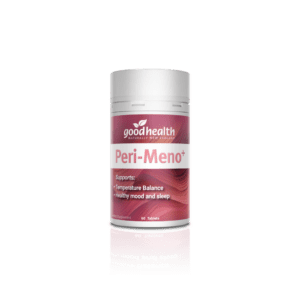
为了庆祝我们的女性健康系列产品的发布,Good Health 自然疗法团队撰写了一系列健康文章,深入探讨奇妙而复杂的三位女士--初潮、月经和更年期。我们还将探讨女性荷尔蒙生命周期和微生物群、可能出现的潜在问题,以及如何支持女性特有的一些祖传秘方。

有时,身为女性感觉就像一个残酷的宇宙玩笑--从青春期到更年期,我们中的许多人每个月都要承受 1-2 周的情感和生理痛苦,而且随着年龄的增长,这种痛苦似乎会越来越严重,当更年期停止时,我们以为终于可以放松一下,喘口气了,但我们却要承受一连串持续不断的干扰,这让每个月的经前期看起来就像在迪斯尼乐园游玩一样......尽管那是最可怕的游乐设施之一!更糟糕的是,女性经常会被医护人员误诊。其实大可不必如此,但你确实需要掌控自己的健康,我们可以从人类进化过程中更一致的生活方式中学到很多东西,比如如何保持荷尔蒙的平衡和良好运作,即使到了老年也是如此。
欢迎阅读第 3 部分--更年期......和围绝经期
在许多文化中,更年期被认为是一种恩赐:在更年期,女性成为了睿智的 "祖母",在支持和指导他人的同时,也可以自由地享受生活的其他方面,包括活力、快乐和性生活,而不再需要承担怀孕的责任。不幸的是,在发达国家,由于我们快节奏的现代生活方式和超加工饮食,妇女在进入围绝经期后会发现自己的生活质量每况愈下。众所周知,更年期症状--体温波动、睡眠不佳、情绪变化、关节僵硬、体重增加、脑迷糊等--困扰着超过 80% 的西方女性。在生育期,雌激素的影响会导致脂肪在乳房、臀部和臀部堆积,而绝经后体重增加的部位可能是中央和内脏(器官周围),尤其是在新陈代谢失调的情况下。
更年期是指女性可生育的月经周期停止,但生育力会在若干年内下降--卵泡消失的速度加快,卵巢体积缩小,卵巢分泌的激素减少。卵巢一般不会完全消失,但肾上腺和脂肪组织会接管重任,制造大部分雄激素和雌激素(主要以雌酮-E1 的形式)。有证据表明,生殖荷尔蒙并不一定非得陷入衰退,只要注重给予身体作为一个健康的人类动物所需要的东西,我们确实可以保持生殖荷尔蒙的平衡和良好运作。
在西方,更年期的年龄也越来越小。我们被告知,更年期症状是意料之中的,我们唯一能做的就是使用外源性(来自体外)激素进行干预,但这可能会带来副作用。许多女性都在寻找自然支持性的方法来解决生殖问题,却没有意识到简单的饮食和生活方式的改变会产生多么大的影响。

生殖激素问题
在中国传统习俗中,女性月经周期的任何部分出现问题都被认为是不正常的,女性的月经应该像太阳升起和落下一样来去自如,更年期应该只是月经停止。更年期应该只是月经的停止,而不应该有脑部迷糊、情绪波动、关节问题或任何其他与 "变化 "相伴的痛苦。 重要提示:如果您对自己的生理周期、围绝经期或更年期有任何担忧,请咨询专业医护人员。
有人认为,过山车式的更年期 "症状 "仅仅是由于女性荷尔蒙的起伏增大,尤其是雌激素水平的下降造成的;然而,越来越清楚的是,新陈代谢失调、压力、营养缺乏和孕酮过低才是主要因素。这些因素必然会影响调节和支持荷尔蒙健康的内脏器官。甲状腺和肝脏的健康对生殖激素的健康尤为重要。
尽管更年期的身体仍然会制造雌激素,但一些西方女性可能会经历一种雌二醇 "戒断",就像 "冷火鸡 "一样,因为她们的身体会产生较少的雌二醇。但雌二醇实际上只有在生育期才需要。有人认为,由于 "雌激素优势",西方女性在生育期会接触到更高水平的雌激素。许多人的孕酮水平较低,雌二醇代谢为 4-OHE1 和 16-OHE1 的能力较差,这与大脑、乳腺组织等的损伤有关。而且,大多数人都会从我们的衣服、包装和环境中接触到异雌激素。
研究表明,导致西方大多数围绝经期妇女经历过山车般的感觉的可能更多的是孕酮的相对下降。其他研究表明,更年期黄体生成素(LH)和卵泡刺激素(FSH)水平较高,是因为调节神经对高于最佳水平的雌二醇失去了敏感性,即 "雌激素优势"。LH 和/或 FSH 激素的增加会导致许多围绝经期妇女出现许多令人不愉快的身体症状。此外,压力、肝脏或甲状腺问题、高组织雌激素和新陈代谢功能障碍等都可能导致催乳素水平病理性增高,这也会引起一些被归咎于 "雌激素不足 "的更年期表现。
有趣的是,当压力水平较高时,雌激素的分泌也会增加,而我们往往并不知情。围绝经期的血液检测可能不能说明全部问题,因为雌激素(雌酮)水平 细胞和组织中 尽管血液中的雌二醇水平明显降低,但雌激素仍然充足,甚至过量。雌酮是由体内许多组织(包括乳房和子宫内膜)中的芳香化酶产生的。芳香化酶会随着年龄的增长而增加。孕酮的作用之一就是帮助这些组织中的细胞将雌激素释放到血液中,经肝脏代谢后排出体外。有证据表明,对我们中的许多人来说,更年期的艰难可能只是雌激素优势和不健康的雌激素/孕酮比例的延续。与此同时,许多西方女性在几年甚至几十年前就已经出现了甲状腺和肝功能受损的情况。不健康的衰老和代谢器官(尤其是肝脏)所承受的压力可能会使雌激素的代谢从相对 "弱而安全 "的代谢物 2-羟基雌酮(2-OHE1)转向 16-羟基雌酮(16-OHE1)和 4-羟基雌酮(4-OHE1)。后两种代谢物与较差的健康状况密切相关。
由于新陈代谢、器官和腺体功能更健康,肥胖率低至零,接触塑料(异雌激素)的机会低至零,压力水平较低,健康的原始人类在其生育期接触雌激素的总体机会较低,卵巢萎缩的可能性也较小。他们似乎在绝经后仍能保持健康数量的所有生殖激素,包括极其重要但经常被忽视的黄体酮,此外,他们还有健康水平的催乳素。她们还能将雌激素代谢为 2-OHE1。
压力是围绝经期激素平衡的一个大问题,因为当我们压力过大时,我们的身体无法代谢雌激素并将其排出体外,我们中的许多人也无法产生足够的睾酮和孕酮来平衡等式。压力也会导致催乳素水平升高。研究表明,猖獗的氧化或氧化还原电位低以及昼夜节律失调--由皮质醇和褪黑激素介导的每日自然光暗周期--会对更年期过渡产生不利影响。我们需要皮质醇在白天升高和降低,但现代生活方式和过度的压力会导致皮质醇水平在夜间升高,或者在错误的时间升高和降低。不幸的是,皮质醇长期升高会导致新陈代谢紊乱,最终导致体重增加。
在围绝经期,孕酮的分泌会减少过多,皮质醇在没有孕酮帮助控制的情况下会上升。更年期皮质醇小幅上升还有其他生理原因,但如果皮质醇上升过多,就会导致体重增加、内分泌紊乱、心血管问题和血糖失衡。孕酮还能防止绝经后雌激素引起问题,尤其是在乳房、大脑或子宫组织中。答案可能是将孕酮水平保持在健康有效的范围内。多晒太阳和保持充足睡眠有助于做到这一点,保持甲状腺和肝脏处于最佳状态,多吃蛋白质和脂肪--为了荷尔蒙健康,要多吃动物蛋白和脂肪,不要吃太多植物蛋白,更不要吃植物油。动物脂肪含有胆固醇,而胆固醇是所有生殖激素和皮质醇的前体。此外,这些受到不公平诽谤的脂肪含有 4 种脂溶性维生素 A、D3、E 和 K2,对生殖激素功能至关重要。
归根结底,对我们许多人来说,更年期似乎是一个新陈代谢、器官和荷尔蒙功能失调的恶性循环。我们的现代生活方式,包括大量超加工食品饮食、高度压力、暴露于污染物和人造光(尤其是在夜间),很可能是造成更年期问题的妇女人数达到流行病比例的罪魁祸首。生活中无处不在的塑料所产生的异雌激素尤其成问题。
研究表明,过度的蓝光照射、化学、空气和塑料污染、饮酒、中枢性肥胖、炎症、精制糖和种子油、药物、营养素缺乏等,都会导致或加剧严重的代谢并发症。荷尔蒙和生殖健康,即使在更年期之后,也是我们所有荷尔蒙之间微妙而神秘的舞蹈。人类具有令人难以置信的适应能力,但现代生活方式似乎已将平衡向错误的方向过度倾斜。
人类祖先的智慧
在全球范围内,有一些 "原始 "人类,他们仍然像数千年前一样,生活在大自然的怀抱中,他们的女性并没有表现出围绝经期症状,也没有在绝经后增加更多的身体脂肪,或者健康状况急剧下降到慢性病的程度。据推测,这是因为他们在进化过程中保持了一贯的生活方式,因而具有健康的新陈代谢和荷尔蒙功能。

主要因素似乎是
- 营养丰富、以动物性食物为主的饮食,不食用超级加工食品
- 健康平衡的微生物群
- 与大地、自然和彼此的深厚联系
- 支持性社会网络
- 适当的活动量
- 几乎没有电磁、塑料、化学或空气污染
- 减轻总体压力
- 享受创造和学习
- 无药物治疗
- 每天接触自然光(几乎没有人造光--LED/荧光灯、屏幕等)
科学研究表明,这些生活方式有助于调节人体昼夜节律、平衡荷尔蒙功能、酣睡、压力管理、氧化还原潜能(健康的氧化和还原过程),以及天然的高 "感觉良好 "荷尔蒙。
如果您是处于围绝经期任何阶段的女性,并且正在经历影响生活质量的生殖激素失衡,您还可以阅读更多有关您可以尝试的支持性措施的信息, 这里.利用祖传的生活方式和饮食因素来支持你的荷尔蒙和新陈代谢,你也许能找到在围绝经期及以后的岁月里保持对生活的热情和乐趣的方法。
草药在传统医学中有着悠久的使用历史,对女性荷尔蒙有很好的支持作用。
介绍: 好健康 Peri-Meno+
好健康 Peri-Meno+ 是一种含有经过科学研究的草药的综合配方,可帮助妇女度过围绝经期和绝经后时期。啤酒花对更年期妇女的体温平衡、情绪、大脑功能和放松都有帮助。众所周知,黑升麻有助于保持健康的情绪和舒适的体温,而葫芦巴则有助于更年期妇女的荷尔蒙平衡。芦根和鼠尾草的加入则是为了支持情绪、大脑健康和功能、压力管理和恢复睡眠。芦根已被证明能支持健康的皮质醇水平。所有这五种草药在传统上都被用来帮助妇女度过更年期,而且还被研究用于支持健康的体重和新陈代谢率,以及心血管和抗氧化功能。

Peri-Meno+ 支持
- 温度舒适度
- 情绪和压力管理
- 健康睡眠
- 荷尔蒙平衡
- 心血管和大脑功能
- 健康的新陈代谢、体重和血糖平衡
点击以下链接,了解更多女性健康系列内容:
TAPS 批准号:PP2522
